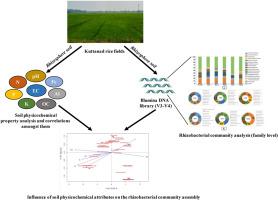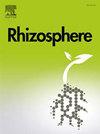酸性硫酸盐土壤的理化性质对水稻根瘤菌群落组成的深刻影响
IF 3.4
3区 生物学
Q1 PLANT SCIENCES
引用次数: 0
摘要
印度喀拉拉邦的 "饭碗 "库塔纳德的卡里地区的土壤因含有黄铁矿沉积物而被称为酸性硫酸盐土壤。除了季节性洪水之外,高酸度和高盐度、金属毒性、养分缺乏、氧化还原波动等多种限制因素也威胁着这些土壤的生产力。要提高这些地区的水稻产量,酸性硫酸盐土壤的可持续管理是当务之急。这些土壤蕴藏着独特的先天微生物群落,它们具有明确的能力,可以进一步加以利用,以实现可持续的改善。开发土壤和作物专用有益微生物菌剂的接种技术有望提高卡里土壤的生产潜力。然而,土壤参数对这些地质不同的土壤中根瘤菌群落的发展有很大影响。我们研究了与水稻生长相关的根瘤菌群落(科级),这些根瘤菌群落生长在地理位置独特的库塔纳德地区的五个硫酸盐酸性土壤系列(普拉克德、瓦伊科姆、安巴拉普扎、塔卡兹和卡拉拉)和一个非硫酸盐酸性土壤系列(穆哈马)中。我们还研究了土壤理化属性对根瘤菌群落形成的影响。我们使用标准程序对土壤理化属性进行了分析,并确定了它们之间存在的相关性。采用元基因组学方法研究了根瘤菌群落(科级),并利用典型对应分析(CCA)将其与土壤参数相关联。与其他酸性硫酸盐地区相比,Thakazhi 和 Kallara 的土壤导电率、可利用氮、钾、有机碳、铝和铁较高,而 pH 值和可利用磷最低。酸性硫酸盐特性与土壤养分含量之间存在着密切的关系。经 Illumina MiSeq 测序后的分类汇总显示,土壤样本中大量的根瘤菌科包括厌氧菌科、Ktedonobacteriaceae、Acidothermaceae、Acidimicrobiaceae、Clostridiaceae、Nocardioidaceae、Xanthobacteriaceae、Methanobacteriaceae、Sphingomonadaceae 和 Peptostreptococcaceae。只有在高酸度硫酸盐土壤样本中才会发现大量的酸温菌科(14%)和酸微菌科(12%)。此外,土壤样本之间只有少数几个共有类群,这表明每个样本的根瘤菌群落都有其独特性。高酸性采样区之间的共有类群包括酸热菌科、Ktedonobacteraceae、酸微菌科、微球菌科、星状菌科和厌氧菌科的成员。CCA 表明,pH 值、EC 值和 Al 含量是影响酸性硫酸盐土壤中生长旺盛的分蘖水稻根瘤菌群的土壤特性,其次是 P 值和 K 值。本文章由计算机程序翻译,如有差异,请以英文原文为准。

Physicochemical properties of acid sulphate soil profoundly influence the composition of rhizobacterial community of rice (Oryza sativa L.)
The soils of kari lands of Kuttanad, the ‘Rice bowl’ of Kerala, India are characterized as acid sulphate as they comprise of pyrite deposits. Productivity in these soils is at stake due to several constraints like high acidity and salinity, metal toxicity, nutrient unavailability, redox fluctuations, besides seasonal flooding. Sustainable management of acid sulphate soil is a critical priority to improve the rice output from these areas. Such soils would harbor unique innate microbial communities with definite abilities which could be exploited further for their sustainable amelioration. Development of inoculant technology with soil and crop specific beneficial microbial agents is expected to boost the production potential of kari soils. However, the soil parameters would impose a great influence on the rhizobacterial community development in these geologically distinct soils. We studied the rhizobacterial communities (at the family level), associated with rice grown in five acid sulphate (Purakkad, Vaikom, Ambalappuzha, Thakazhi and Kallara) as well as one non-acid sulphate (Muhamma) soil series of geographically unique Kuttanad region. We also examined the effects of soil physicochemical attributes on shaping the rhizosphere bacterial community assemblage. The soil physicochemical attributes were analyzed using standard procedures and correlations existing amongst them were also determined. A metagenomic approach was adopted to study the rhizobacterial communities (family level) and were correlated with soil parameters using canonical correspondence analysis (CCA). Compared to other acid sulphate regions, Thakazhi and Kallara soils indicated higher electrical conductivity, available nitrogen, potassium, organic carbon, aluminium as well as iron and lowest pH and available phosphorus. Intense significant relationships were exhibited amongst the acid sulphate properties and soil nutrient contents. The taxa summary after the Illumina MiSeq sequencing revealed the abundant rhizobacterial families in the soil samples as Anaerolineaceae, Ktedonobacteriaceae, Acidothermaceae, Acidimicrobiaceae, Clostridiaceae, Nocardioidaceae, Xanthobacteraceae, Methanobacteriaceae, Sphingomonadaceae and Peptostreptococcaceae. Acidothermaceae (14%) and Acidimicrobiaceae (12%) were found abundant exclusively in highly acid sulphate soil samples. Moreover, only a few shared taxa were observed between the soil samples, which denoted the uniqueness of each sample in terms of rhizobacterial communities. The shared taxa between highly acidic sampling areas include members of Acidothermaceae, Ktedonobacteraceae, Acidimicrobiaceae, Micrococcaceae, Stellaceae and Anaerolineaceae. CCA showed that pH, EC and Al content were the soil properties governing the bacterial assembly in the rhizosphere of actively tillering rice grown in acid sulphate soil followed by P and K. The data generated in the present study are considered to be of use in developing consortia of kari soil specific rice rhizosphere microbial agents which could be used as inoculants in future.
求助全文
通过发布文献求助,成功后即可免费获取论文全文。
去求助
来源期刊

Rhizosphere
Agricultural and Biological Sciences-Agronomy and Crop Science
CiteScore
5.70
自引率
8.10%
发文量
155
审稿时长
29 days
期刊介绍:
Rhizosphere aims to advance the frontier of our understanding of plant-soil interactions. Rhizosphere is a multidisciplinary journal that publishes research on the interactions between plant roots, soil organisms, nutrients, and water. Except carbon fixation by photosynthesis, plants obtain all other elements primarily from soil through roots.
We are beginning to understand how communications at the rhizosphere, with soil organisms and other plant species, affect root exudates and nutrient uptake. This rapidly evolving subject utilizes molecular biology and genomic tools, food web or community structure manipulations, high performance liquid chromatography, isotopic analysis, diverse spectroscopic analytics, tomography and other microscopy, complex statistical and modeling tools.
 求助内容:
求助内容: 应助结果提醒方式:
应助结果提醒方式:


